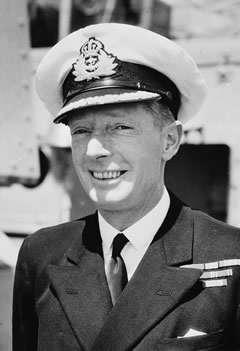- Author
- Dennard, Luke, Midshipman, RAN
- Subjects
- Biographies and personal histories, Ship histories and stories, WWII operations
- Tags
-
- RAN Ships
- HMAS Shropshire, HMAS Australia II, HMAS Sydney II
- Publication
- December 2007 edition of the Naval Historical Review (all rights reserved)
This essay will discuss the role of Sir John Collins in reference to his career in the Mediterranean and Pacific theatres of World War II as captain and commodore in the Royal Australian Navy and subsequent appointments, and argue that he rallied a nation and its allies in the darkest days of war. Areas covered in analysing Collins’s leadership include his significant achievements, the leadership style he employed, the type of relationships he held with subordinates and seniors, intellectual qualities and the decisions made which changed the course of history.
Significant Achievements

Collins assumed command of the cruiser HMAS Sydney on 16th November 1939. By the middle of May 1940 Italy had entered the war, with Sydney in action soon after in the Mediterranean as part of the British Mediterranean Fleet. Sydney, as part of a force covering a Malta convoy, engaged in her first battle, making contact with three Italian destroyers, one of which was the Espero, a markedly faster ship. Sydney subsequently sank the destroyer and rescued survivors.
The most significant victory for Collins in the Mediterranean was the sinking of the Italian cruiser Bartolomeo Colleoni, a significantly faster vessel, off Crete in July 1940. Sydney, with five British destroyers, opened fire on the cruiser with the main damage occurring when a shell from Sydney struck the boiler room, which stopped the ship, which was subsequently sunk by torpedoes.
Admiral Cunningham’s assessment of the action taken by Collins highlights the importance of Collins’ decisive leadership in a pivotal time of the war:
‘The credit for this successful and gallant action belongs mainly to Captain J.A. Collins who by quick appreciation of the situation, offensive spirit and handling of HMAS Sydney, achieved a victory over a superior force which has important strategic effects … It shows the results obtainable by an efficient control team backed by good material…’
Following victory, Collins, paying tribute to his crew, remarked:
‘They carried on so coolly that one would have thought it was a training exercise off the Australian coast. They sang and joked, and generally behaved as if it were a picnic, but their gunnery skills were magnificent. Their courage was up to my expectations.’
Commander Edwards’s assessment of this tribute by Collins follows: ‘The last sentence is one of those classic examples of emphasis by understatement which so often come from naval officers – and all too seldom from others.’ The victory ultimately proved Australia’s commitment, skill and tenacity in the war at a time of great losses for the Allies. The Australian public’s interest along with the media attention was immense.
The second major theatre of World War II in which Collins served in was in the Pacific as captain of HMAS Shropshire from 1943 and served alongside United States (US) forces in the battle against Japan. In May, 1944 Collins was relieved of command of Shropshire and hoisted his broad pennant in HMAS Australia as commodore in command of HMA Squadron. This was an historic moment in the history of the RAN as it was the first time Australia’s navy was led by an Australian born and trained officer.
During this time, Collins’ recollections of the US Navy through his autobiography highlights two significant leadership principles he held closely. Firstly, he valued and encouraged initiative stating: ‘I found the US Navy invariably obeyed orders almost blindly, and the orders were often so detailed as to cramp initiative.’ The second principle was based on how enlisted men were treated, describing the US Navy as rigid in discipline and in some instances ‘… a tendency to disregard the convenience of the enlisted men’ was apparent, citing the example ‘… drivers were often left ignorant by their officer passengers as to whether the wait would be minutes or hours,’ and showed Collins’ understanding in the maintenance of communication in effective discipline.
On 21st October 1944, Japanese aircraft attacked Australia in the battle for Leyte Gulf with one crashing directly above the bridge, nearly 100 Australian officers and men were killed or badly wounded including Commodore Collins who was seriously injured. Having contributed successfully to the war effort in the Pacific as commander of HMA Squadron, Collins would require many months of rehabilitation and rejoined the Fleet on 22nd July 1945.




